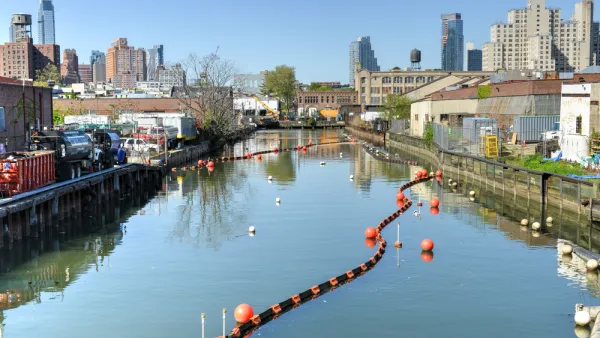The EPA has released plans for how it intends to clean up Brooklyn's Gowanus Canal Superfund site. Branden Klayko reports on the $500 million, two pronged approach.
Brooklyn's 1.8-mile-long Gowanus Canal is at once one of New York's most toxic environments and the centerpiece of what could one day become one of the city's most sought after neighborhoods. Klayko reviews the $500 million plan outlined by the Environmental Protection Agency (EPA), in collaboration with the New York State Department of Environmental Conservation (NYSDEC), that will facilitate this transformation. The "dual approach", would "dredge and cap the canal bottom and improve the city’s combined sewer overflow (CSO) problem that dumps raw sewage and other contaminants into the canal during heavy rainfall."
"To remove existing contaminants deposited by 150 years of industrial use from factories, tanneries, and refineries, ten feet of sediment from two heavily contaminated portions of the canal will be removed and capped with a mix of concrete, clay, and sand," explains Klayko. "A less-contaminated segment will also be dredged and capped with sand."
"Two underground retention basins costing $78 million are proposed at two of the worst CSO sites, to store sewage until nearby water treatment facilities can handle it. Smaller-scale improvements, including green storm-water management, to capture and hold rainwater on surrounding streets, and an environmental restoration project, the Gowanus Canal Sponge Park, designed by Brooklyn-based dlandstudio and funded by city and federal grants, will also help reduce storm-water discharges."
FULL STORY: Water Wash

National Parks Layoffs Will Cause Communities to Lose Billions
Thousands of essential park workers were laid off this week, just before the busy spring break season.

Retro-silient?: America’s First “Eco-burb,” The Woodlands Turns 50
A master-planned community north of Houston offers lessons on green infrastructure and resilient design, but falls short of its founder’s lofty affordability and walkability goals.

Delivering for America Plan Will Downgrade Mail Service in at Least 49.5 Percent of Zip Codes
Republican and Democrat lawmakers criticize the plan for its disproportionate negative impact on rural communities.

Test News Post 1
This is a summary

Test News Headline 46
Test for the image on the front page.

Balancing Bombs and Butterflies: How the National Guard Protects a Rare Species
The National Guard at Fort Indiantown Gap uses GIS technology and land management strategies to balance military training with conservation efforts, ensuring the survival of the rare eastern regal fritillary butterfly.
Urban Design for Planners 1: Software Tools
This six-course series explores essential urban design concepts using open source software and equips planners with the tools they need to participate fully in the urban design process.
Planning for Universal Design
Learn the tools for implementing Universal Design in planning regulations.
EMC Planning Group, Inc.
Planetizen
Planetizen
Mpact (formerly Rail~Volution)
Great Falls Development Authority, Inc.
HUDs Office of Policy Development and Research
NYU Wagner Graduate School of Public Service



























